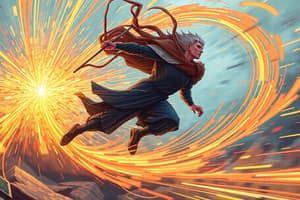Podcast
Questions and Answers
What is the main cause of resistance experienced when two surfaces slide against each other?
What is the main cause of resistance experienced when two surfaces slide against each other?
- Gravity acting on the surfaces
- Contact forces between the surfaces
- Intermolecular forces between the surfaces (correct)
- Electromagnetism between the surfaces
Which of the following is NOT a factor influencing the strength of friction between surfaces?
Which of the following is NOT a factor influencing the strength of friction between surfaces?
- Nature of the surfaces
- Density of the surfaces (correct)
- Applied force
- Angle between the surfaces
Rubber soles have more friction on a wet wooden floor than on a smooth ice rink due to differences in:
Rubber soles have more friction on a wet wooden floor than on a smooth ice rink due to differences in:
- Surface temperature
- Surface density
- Surface roughness (correct)
- Surface area
In physics, which unit is used to measure force according to the International System of Units (ISU)?
In physics, which unit is used to measure force according to the International System of Units (ISU)?
What type of forces occur when two objects interact with each other?
What type of forces occur when two objects interact with each other?
What type of friction occurs when an object is stationary and an applied force is equal to the friction force?
What type of friction occurs when an object is stationary and an applied force is equal to the friction force?
Which fundamental concept in physics involves a push or pull that causes an object to change its state of motion or shape?
Which fundamental concept in physics involves a push or pull that causes an object to change its state of motion or shape?
In the context of the text, what happens when the applied force exceeds the maximum friction force between an object and a surface?
In the context of the text, what happens when the applied force exceeds the maximum friction force between an object and a surface?
Which type of friction occurs when an object is already in motion?
Which type of friction occurs when an object is already in motion?
What balances the force applied when lowering a heavy box to the floor, preventing it from sliding out of your hands?
What balances the force applied when lowering a heavy box to the floor, preventing it from sliding out of your hands?
When you press the brake pedal in a vehicle, what causes the vehicle to slow down?
When you press the brake pedal in a vehicle, what causes the vehicle to slow down?
Which concept in physics is essential for understanding how objects move and interact with each other?
Which concept in physics is essential for understanding how objects move and interact with each other?
Flashcards are hidden until you start studying
Study Notes
Understanding Force and Friction
When you push a cart across a smooth floor or try to lift a heavy box, you're engaging with two fundamental concepts in physics: force and friction. In this article, we'll explore these principles, examining their relationship and providing some practical examples.
Force
Force is a push or a pull that causes an object to change its state of motion or its shape. This concept was first quantified by Sir Isaac Newton, and it's often described as "mass times acceleration." The unit of force in the International System of Units (ISU) is the Newton (N).
Forces can be classified into two major categories: contact forces and field forces. Contact forces occur when two objects interact with each other, like the force between your hand and the cart handle. Field forces are generated by fields, such as gravity or electromagnetism.
Friction
Friction is the resistance experienced when two surfaces slide against each other or when an object moves over a surface. This resistance is caused by intermolecular forces between the surfaces, which can be thought of as a "sticky" force. Friction opposes motion and allows us to maintain contact with and move objects around us.
Friction's strength depends on the nature of the surfaces involved. For example, rubber soles have more friction on a wet wooden floor than on a smooth ice rink. Friction can also change based on the applied force and the angle between the surfaces.
Friction and Force Interactions
The relationship between force and friction is most evident when an object is stationary on a surface. In this case, a force is required to overcome the friction between the object and the surface. When the applied force exceeds the maximum friction force, the object begins to move.
When an object doesn't move, despite being pushed by an external force, the force applied is equal to the friction force. This situation is known as static friction. When the object is in motion, the friction force is smaller, and a smaller force is required to keep it moving; this situation is known as kinetic friction.
Applications of Force and Friction
Force and friction are concepts that are ubiquitous in our daily lives. For example, the force you apply when lowering a heavy box to the floor is balanced by the friction between the box and the floor, preventing the box from sliding out of your hands.
The same principle applies to the mechanism of brakes. When you press the brake pedal, the brake pads exert a force on the rotating discs, causing them to slow down. This force is supported by friction between the rotating discs and the brake pads, slowing the vehicle's motion.
Conclusion
Force and friction are fundamental concepts in physics that we encounter in our daily lives. An understanding of these principles is essential for appreciating and manipulating how objects move and interact with one another. By examining the relationships between these two concepts, we can better understand the world around us and develop innovative solutions to challenging problems.
Studying That Suits You
Use AI to generate personalized quizzes and flashcards to suit your learning preferences.




